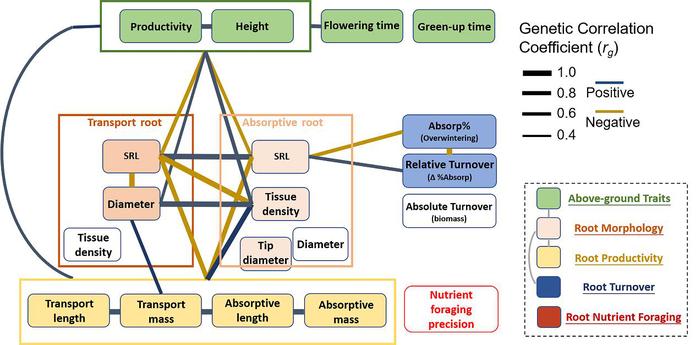Title: The genetic basis of the root economics spectrum in a perennial grass
Weile Chen, Yanqi Wu, Felix B. Fritschi, and Thomas E. Juenger
PNAS November 23, 2021 118 (47) e2107541118; https://doi.org/10.1073/pnas.2107541118
Edited by Elizabeth A. Kellogg, Donald Danforth Plant Science Center, St. Louis, MO, and approved October 20, 2021 (received for review April 23, 2021)
Abstract
Construction economics of plant roots exhibit predictable relationships with root growth, death, and nutrient uptake strategies. Plant taxa with inexpensively constructed roots tend to more precisely explore nutrient hotspots than do those with costly constructed roots but at the price of more frequent tissue turnover. This trade-off underlies an acquisitive to conservative continuum in resource investment, described as the “root economics spectrum (RES).” Yet the adaptive role and genetic basis of RES remain largely unclear. Different ecotypes of switchgrass (Panicum virgatum) display root features exemplifying the RES, with costly constructed roots in southern lowland and inexpensively constructed roots in northern upland ecotypes. We used an outbred genetic mapping population derived from lowland and upland switchgrass ecotypes to examine the genetic architecture of the RES. We found that absorptive roots (distal first and second orders) were often “deciduous” in winter. The percentage of overwintering absorptive roots was decreased by northern upland alleles compared with southern lowland alleles, suggesting a locally-adapted conservative strategy in warmer and acquisitive strategy in colder regions. Relative turnover of absorptive roots was genetically negatively correlated with their biomass investment per unit root length, suggesting that the key trade-off in framing RES is genetically facilitated. We also detected strong genetic correlations among root morphology, root productivity, and shoot size. Overall, our results reveal the genetic architecture of multiple traits that likely impacts the evolution of RES and plant aboveground–belowground organization. In practice, we provide genetic evidence that increasing switchgrass yield for bioenergy does not directly conflict with enhancing its root-derived carbon sequestration.
Link: https://www.pnas.org/content/118/47/e2107541118






